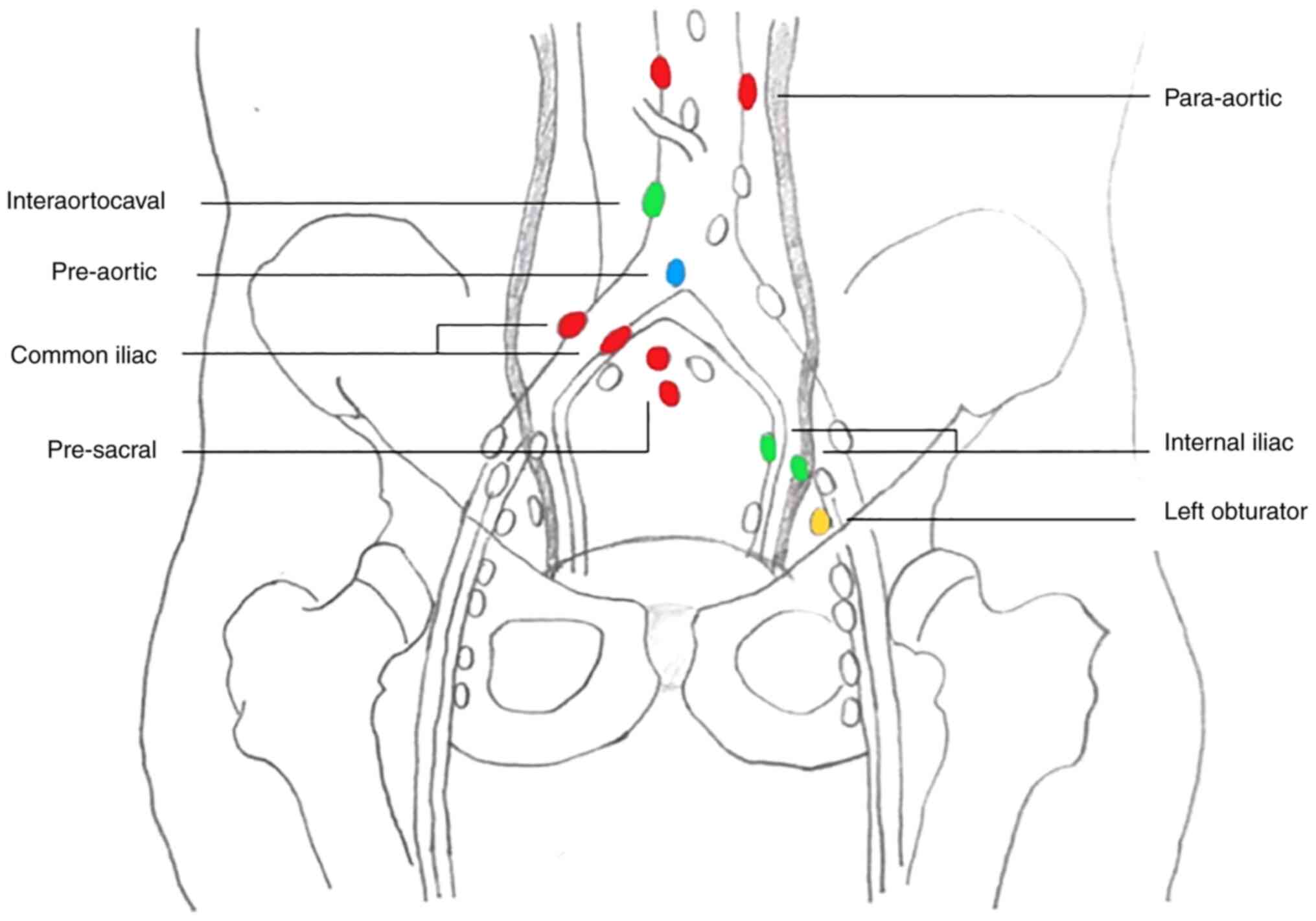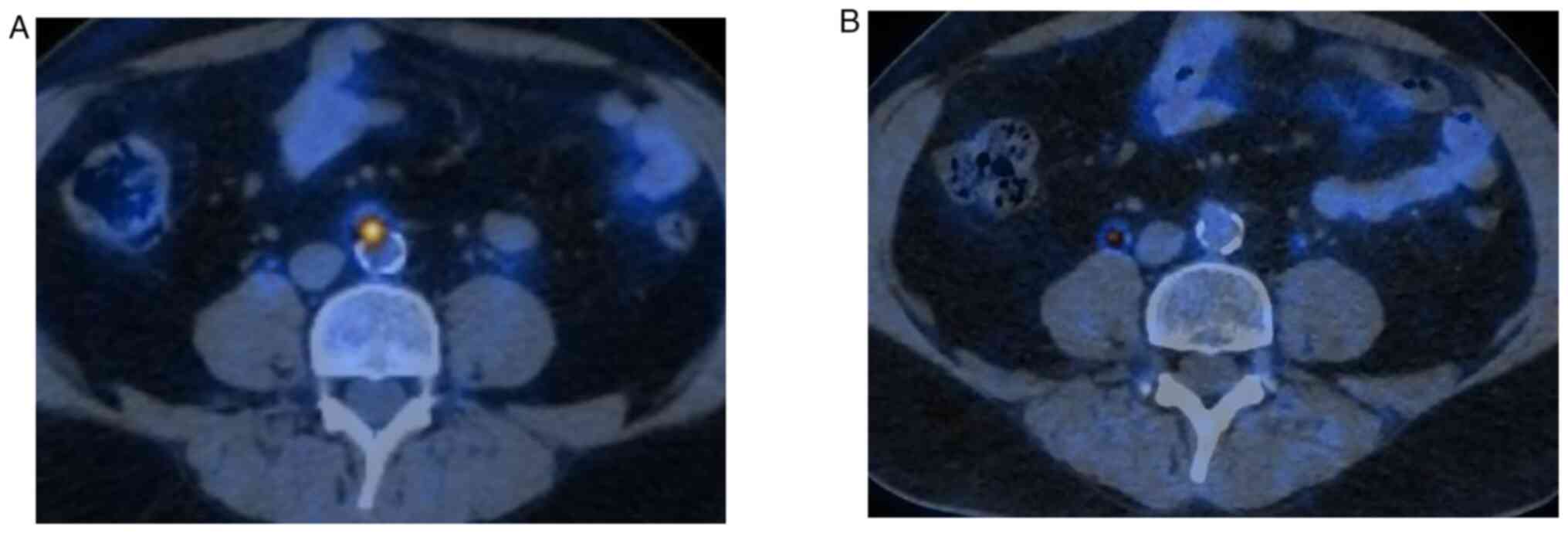|
1
|
Rouprêt M, Babjuk M, Compérat E, Zigeuner
R, Sylvester RJ, Burger M, Cowan NC, Böhle A, Van Rhijn BW,
Kaasinen E, et al: European association of urology guidelines on
upper urinary tract urothelial cell carcinoma: 2015 update. Eur
Urol. 68:868–879. 2015.PubMed/NCBI View Article : Google Scholar
|
|
2
|
Noone AM, Howlader N, Krapcho M, Miller D,
Brest A, Yu M, Ruhl J, Tatalovich Z, Mariotto A, Lewis DR (eds), et
al: SEER Cancer Statistics Review 1975-2015. National Cancer
Institute, Bethesda, MD, 2018.
|
|
3
|
Spiess PE, Agarwal N, Bangs R, Boorjian
SA, Buyyounouski MK, Clark PE, Downs TM, Efstathiou JA, Flaig TW,
Friedlander T, et al: Bladder Cancer, Version 5.2017, NCCN Clinical
Practice Guidelines in Oncology. J Natl Compr Canc Netw.
15:1240–1267. 2017.PubMed/NCBI View Article : Google Scholar
|
|
4
|
Siefker-Radtke AO, Walsh GL, Pisters LL,
Shen Y, Swanson DA, Logothetis CJ and Millikan RE: Is there a role
for surgery in the management of metastatic urothelial cancer? The
M. D. Anderson experience. J Urol. 171:145–148. 2004.PubMed/NCBI View Article : Google Scholar
|
|
5
|
Lehmann J, Suttmann H, Albers P, Volkmer
B, Gschwend JE, Fechner G, Spahn M, Heidenreich A, Odenthal A, Seif
C, et al: Surgery for metastatic urothelial carcinoma with curative
intent: The German experience (AUO AB 30/05). Eur Urol.
55:1293–1299. 2009.PubMed/NCBI View Article : Google Scholar
|
|
6
|
Dodd PM, McCaffrey JA, Herr H, Mazumdar M,
Bacik J, Higgins G, Boyle MG, Scher HI and Bajorin DF: Outcome of
postchemotherapy surgery after treatment with methotrexate,
vinblastine, doxorubicin, and cisplatin in patients with
unresectable or metastatic transitional cell carcinoma. J Clin
Oncol. 17:2546–2552. 1999.PubMed/NCBI View Article : Google Scholar
|
|
7
|
Abe T, Shinohara N, Harabayashi T, Sazawa
A, Maruyama S, Suzuki S and Nonomura K: Impact of multimodal
treatment on survival in patients with metastatic urothelial
cancer. Eur Urol. 52:1106–1113. 2007.PubMed/NCBI View Article : Google Scholar
|
|
8
|
Deodato F, Ferro M, Cilla S, Ianiro A,
Buwenge M, Re A, Sallustio G, Valentini V, Morganti AG and Macchia
G: Stereobody radiotherapy for nodal recurrences in oligometastatic
patients: A pooled analysis from two phase I clinical trials. Clin
Exp Metastasis. 37:519–529. 2020.PubMed/NCBI View Article : Google Scholar
|
|
9
|
Riley DS, Barber MS, Kienle GS, Aronson
JK, von Schoen-Angerer T, Tugwell P, Kiene H, Helfand M, Altman DG,
Sox H, et al: CARE guidelines for case reports: Explanation and
elaboration document. J Clin Epidemiol. 89:218–235. 2017.PubMed/NCBI View Article : Google Scholar
|
|
10
|
Brierley JD, Gospodarowicz MK and
Wittekind C (eds): TNM Classification of Malignant Tumours. 8th
edition. John Wiley & Sons, Inc. Hoboken, NJ, pp1-272,
2017.
|
|
11
|
Compérat EM, Burger M, Gontero P, Mostafid
AH, Palou J, Rouprêt M, van Rhijn BWG, Shariat SF, Sylvester RJ,
Zigeuner R and Babjuk M: Grading of urothelial carcinoma and the
new ‘World health organisation classification of tumours of the
urinary system and male genital organs 2016’. Eur Urol Focus.
5:457–466. 2019.PubMed/NCBI View Article : Google Scholar
|
|
12
|
Margulis V, Shariat SF, Matin SF, Kamat
AM, Zigeuner R, Kikuchi E, Lotan Y, Weizer A, Raman JD and Wood CG:
Upper Tract Urothelial Carcinoma CollaborationThe Upper Tract
Urothelial Carcinoma Collaboration. Outcomes of radical
nephroureterectomy: A series from the Upper Tract Urothelial
Carcinoma Collaboration. Cancer. 115:1224–1233. 2009.PubMed/NCBI View Article : Google Scholar
|
|
13
|
Hellman S and Weichselbaum RR:
Oligometastases. J Clin Oncol. 13:8–10. 1995.PubMed/NCBI View Article : Google Scholar
|
|
14
|
Loi M, Frelinghuysen M, Klass ND, Oomen-De
Hoop E, Granton PV, Aerts J, Verhoef C and Nuyttens J: Locoregional
control and survival after lymph node SBRT in oligometastatic
disease. Clin Exp Metastasis. 35:625–633. 2018.PubMed/NCBI View Article : Google Scholar
|
|
15
|
Francolini G, Desideri I, Detti B, Di
Cataldo V, Masi L, Caramia G, Visani L, Terziani F, Muntoni C, Lo
Russo M, et al: Stereotactic radiotherapy in oligoprogressive and
oligorecurrent urothelial cancer patients: A retrospective
experience. Cancer Treat Res Commun. 19(100124)2019.PubMed/NCBI View Article : Google Scholar
|
|
16
|
Deodato F, Macchia G, Buwenge M, Bonetti
M, Cilla S, Zamagni A, Re A, Pezzulla D, Cellini F, Strigari L, et
al: Systematic review of stereotactic body radiotherapy for nodal
metastases. Clin Exp Metastasis. 38:11–29. 2021.PubMed/NCBI View Article : Google Scholar
|
|
17
|
Seo YS, Kim MS, Cho CK, Yoo HJ, Jang WI,
Kim KB, Lee DH, Moon SM and Lee HR: Stereotactic body radiotherapy
for oligometastases confined to the para-aortic region: Clinical
outcomes and the significance of radiotherapy field and dose.
Cancer Invest. 33:180–187. 2015.PubMed/NCBI View Article : Google Scholar
|
|
18
|
Kneebone A, Hruby G, Ainsworth H, Byrne K,
Brown C, Guo L, Guminski A and Eade T: Stereotactic body
radiotherapy for oligometastatic prostate cancer detected via
prostate-specific membrane antigen positron emission tomography.
Eur Urol Oncol. 1:531–537. 2018.PubMed/NCBI View Article : Google Scholar
|
|
19
|
Detti B, D'Angelillo RM, Ingrosso G,
Olmetto E, Francolini G, Triggiani L, Bruni A, Borghesi S, Fondelli
S, Carfagno T, et al: Combining abiraterone and radiotherapy in
prostate cancer patients who progressed during abiraterone therapy.
Anticancer Res. 37:3717–3722. 2017.PubMed/NCBI View Article : Google Scholar
|
|
20
|
Sundahl N, Vandekerkhove G, Decaestecker
K, Meireson A, De Visschere P, Fonteyne V, De Maeseneer D, Reynders
D, Goetghebeur E, Van Dorpe J, et al: Randomized phase 1 trial of
pembrolizumab with sequential versus concomitant stereotactic body
radiotherapy in metastatic urothelial carcinoma. Eur Urol.
75:707–711. 2019.PubMed/NCBI View Article : Google Scholar
|
















